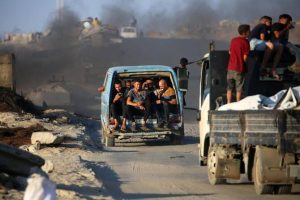Forging Unity Amidst Shared Challenges: A Call for Collaborative Action in Syria, Lebanon, and Jordan

Forging Unity Amidst Shared Challenges: A Call for Collaborative Action in Syria, Lebanon, and Jordan
The intricate web of political, security, humanitarian, and economic dynamics enveloping Syria, Lebanon, and Jordan underscores their deep interconnection. Changes in one of these neighboring nations reverberate across the others, magnifying the significance of their shared destinies. As prosperity ripples through one, so does turmoil. The origins of many ongoing challenges in this Levantine trio can be traced back to the Syrian civil war, a conflict that has not only ravaged infrastructure but disrupted production and manufacturing processes, impacting both the directly involved country and its neighbors.
The enduring echoes of the Syrian conflict continue to cast a shadow over Lebanon and Jordan. The conflict’s ripple effects extend into their territories, particularly in the southern regions of Syria. Notably, Deraa, a strategically vital city and birthplace of the uprising, lies close to Jordan’s border, underscoring the interconnectedness of regional dynamics.
Moreover, the staggering influx of Syrian refugees into Lebanon and Jordan has added complexity to their challenges. This prolonged refugee crisis, the largest worldwide, has stretched resources and capacities to the limit. Jordan, in particular, bears the weight of hosting the second-largest number of refugees per capita globally.
The socio-economic repercussions of these dynamics are evident. All three nations grapple with high unemployment rates, while Lebanon’s economic crisis ranks among the world’s worst in two centuries. Inflation and food insecurity exacerbate citizens’ plight. Syria’s currency has plummeted, making it one of the world’s highest-inflation countries, only surpassed by a few.
However, amid these daunting challenges lies an opportunity for transformation. A united and determined political will can pave the path towards a comprehensive, long-term vision that addresses economic, humanitarian, and political dimensions. Just as Saudi Arabia’s Vision 2030 and the UAE’s “We the UAE 2031” initiative chart their nations’ courses towards prosperity, Syria, Lebanon, and Jordan can collaborate on a shared vision.
Security cooperation, border protection, political stability, and investment promotion form essential pillars of this endeavor. By leveraging their historical and cultural significance, these nations can capitalize on their tourist appeal and embark on infrastructure development, bridging power shortages and food insecurity. Addressing the Syrian refugee crisis with a focus on their safe return home is equally pivotal.
While results may not be immediate, a commitment to this collaborative vision will undoubtedly yield positive change over time. Like Rome, their transformation will be gradual yet profound. These nations’ historical contributions to civilization underscore their potential to not only address current challenges but also inspire others through their cooperative journey.
In essence, Syria, Lebanon, and Jordan are intertwined in a tapestry of political, economic, social, and security complexities. Through united efforts and multi-faceted cooperation, they can chart a course towards a more promising future, proving that shared challenges can indeed be overcome through unity and collective action.
The intricate connections across the political, security, humanitarian, and economic domains of Lebanon, Syria, and Jordan cannot be overstated. These neighboring Arab nations share a dynamic where advancements or setbacks in one inevitably reverberate through the others, illustrating a compelling need for coordinated efforts in tackling shared challenges.
The genesis of many of their ongoing predicaments can be traced back to the Syrian civil war, which not only brought physical devastation but also disrupted vital production and manufacturing processes across these intertwined territories.
Both Lebanon and Jordan continue to grapple with the spill-over repercussions of the Syrian conflict, which remains unresolved in some regions. Southern areas of Syria, notably Deraa, near the borders of Jordan and the Golan Heights, still bear the brunt of instability.
Furthermore, the mass influx of Syrian refugees into Lebanon and Jordan has deepened the complexity. Syria’s refugee crisis persists as one of the world’s largest, prompting these nations to host a significant portion. Jordan now shelters approximately 675,000 Syrian refugees, while Lebanon hosts a staggering number per capita, compounded by economic hardships.
This has led to escalating economic difficulties across the region, with unemployment rates exceeding 10% and Lebanon grappling with one of the worst global economic crises in centuries. Syrians face surging food insecurity and hyperinflation.
Yet, amidst these trials, lies a promising avenue for progress through joint efforts.




